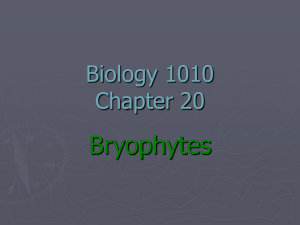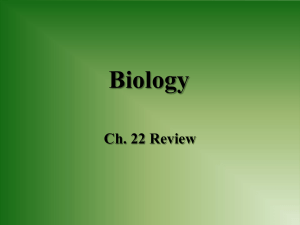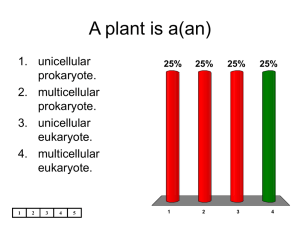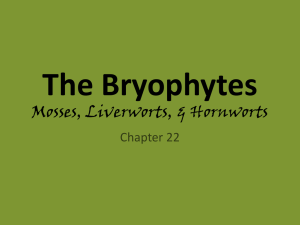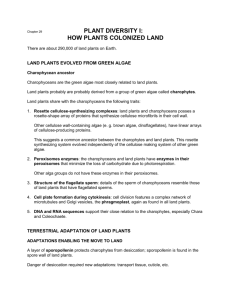BROYPHYTES & FERNS:
advertisement
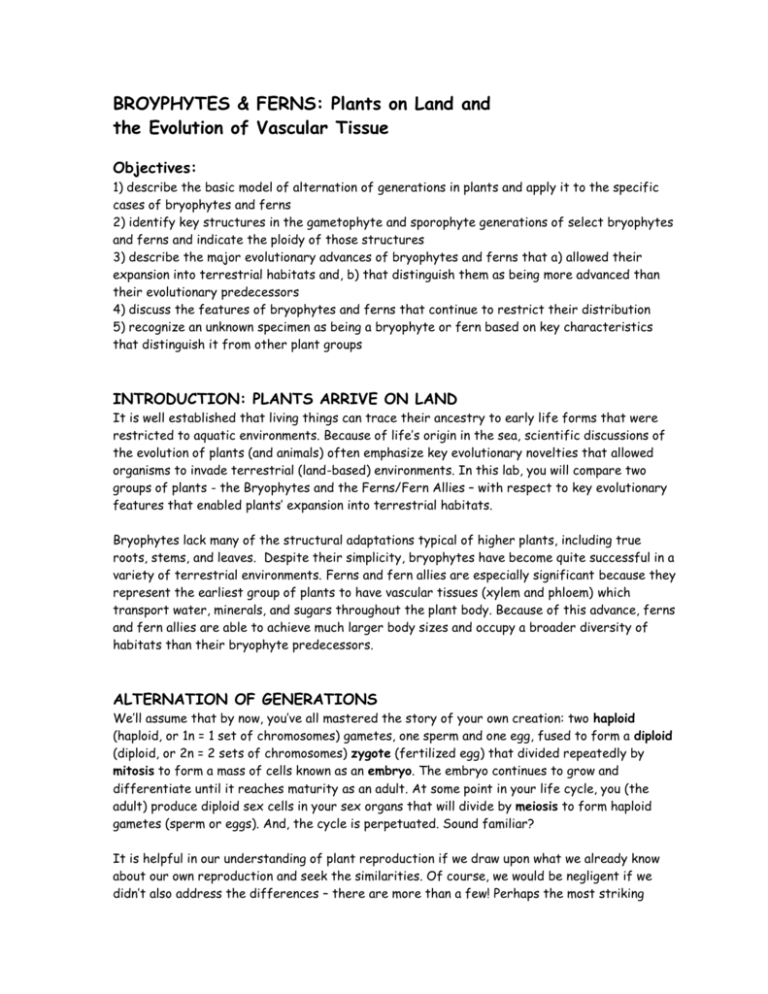
BROYPHYTES & FERNS: Plants on Land and the Evolution of Vascular Tissue Objectives: 1) describe the basic model of alternation of generations in plants and apply it to the specific cases of bryophytes and ferns 2) identify key structures in the gametophyte and sporophyte generations of select bryophytes and ferns and indicate the ploidy of those structures 3) describe the major evolutionary advances of bryophytes and ferns that a) allowed their expansion into terrestrial habitats and, b) that distinguish them as being more advanced than their evolutionary predecessors 4) discuss the features of bryophytes and ferns that continue to restrict their distribution 5) recognize an unknown specimen as being a bryophyte or fern based on key characteristics that distinguish it from other plant groups INTRODUCTION: PLANTS ARRIVE ON LAND It is well established that living things can trace their ancestry to early life forms that were restricted to aquatic environments. Because of life’s origin in the sea, scientific discussions of the evolution of plants (and animals) often emphasize key evolutionary novelties that allowed organisms to invade terrestrial (land-based) environments. In this lab, you will compare two groups of plants - the Bryophytes and the Ferns/Fern Allies – with respect to key evolutionary features that enabled plants’ expansion into terrestrial habitats. Bryophytes lack many of the structural adaptations typical of higher plants, including true roots, stems, and leaves. Despite their simplicity, bryophytes have become quite successful in a variety of terrestrial environments. Ferns and fern allies are especially significant because they represent the earliest group of plants to have vascular tissues (xylem and phloem) which transport water, minerals, and sugars throughout the plant body. Because of this advance, ferns and fern allies are able to achieve much larger body sizes and occupy a broader diversity of habitats than their bryophyte predecessors. ALTERNATION OF GENERATIONS We’ll assume that by now, you’ve all mastered the story of your own creation: two haploid (haploid, or 1n = 1 set of chromosomes) gametes, one sperm and one egg, fused to form a diploid (diploid, or 2n = 2 sets of chromosomes) zygote (fertilized egg) that divided repeatedly by mitosis to form a mass of cells known as an embryo. The embryo continues to grow and differentiate until it reaches maturity as an adult. At some point in your life cycle, you (the adult) produce diploid sex cells in your sex organs that will divide by meiosis to form haploid gametes (sperm or eggs). And, the cycle is perpetuated. Sound familiar? It is helpful in our understanding of plant reproduction if we draw upon what we already know about our own reproduction and seek the similarities. Of course, we would be negligent if we didn’t also address the differences – there are more than a few! Perhaps the most striking difference between plant and animal life cycles is that plants spend part of their life cycle in a haploid (1n) phase, and part of their life cycle in a diploid (2n) phase. This type of life cycle, known as “alternation of generations”, is characteristic of all plants, and also occurs in a few other non-plant organisms, including most algae. You, as well as most animals, only exist in a diploid (2n) state regardless of where you are in your life cycle. With the exception of the bryophytes, most organisms that you recognize as “plants” represent only the diploid sporophyte generation of that plant. “Sporophyte” literally means “spore plant” or “spore-producing plant”. Sporangia (singular: sporangium) are the structures located on the body of the sporophyte where spores are produced. Diploid cells inside sporangia undergo meiosis to produce haploid spores. The haploid spores germinate (grow) to give rise to the other generation: the haploid gametophyte. “Gametophyte” literally means “gamete plant” or “gamete-producing plant”. Not surprisingly then, you will find structures on the gametophyte where the gametes (sperm and eggs) are produced. Antheridia (singular: antheridium) are the structures where sperm are produced; archegonia (singular: archegonium) are structures where eggs are produced. Through a variety of sometimes remarkable, if not downright bizarre mechanisms, sperm and egg are eventually united and fuse to form the diploid zygote that will eventually grow by mitosis into a new sporophyte. Human Life Cycle: cells in testes undergo meiosis Male Sperm fuse to form Zygote cells in ovaries undergo meiosis Eggs Female growth by mitosis Embryo growth by mitosis Plant Life Cycle: Alternation of Generations Spores (1n) cells in sporangium undergo meiosis growth by mitosis Haploid Sporophyte (2n) Gametophyte (1n) Diploid growth by mitosis produces Zygote (2n) Gametes (1n) fuse to form PHYLUM BRYOPHYTA: MOSSES, LIVERWORTS, HORNWORTS Angiosperms Gymnosperms Ferns flowers, fruits seeds *Bryophytes pollen vascular tissue Green Algae dominant sporophyte dominant gametophyte flagellated sperm Chlorophylls a, b The Phylum Bryophyta includes 3 groups of plants – the mosses, liverworts, and hornworts. Bryophytes are probably the best example of what the earliest plants may have looked like. The body of bryophytes is relatively undifferentiated and lacks true roots, stems, and leaves. The bryophyte body is sometimes referred to as "thallus", a term used to refer to generalized, undifferentiated plant tissue. Threadlike structures called rhizoids can be found on the lower surface of the thallus that are considered important for anchoring the plant to the substrate but do not have a role in water absorption. Bryophyte distribution tends to be somewhat restricted to moist environments. Bryophytes lack vascular tissues (xylem and phloem) and are therefore unable to transport water and dissolved substances from one part of the plant body to another. Because of their reliance on diffusion for transport, bryophytes cannot obtain large body sizes that might be typical of higher plants. Water is also required for bryophyte reproduction - flagellated sperm released into the environment must swim through a liquid medium in order to make their way to an egg in a nearby archegonium. Because of these constraints, bryophytes are found predominantly in moist areas in forests and close to streams, bogs, wetlands, ponds, etc. . . Having said that, some bryophytes have an also be found in rather extreme environments, such as deserts, the Arctic and Antarctic, and mountaintops well above timberline. Ecologically, bryophytes are important for a number of reasons. In some habitats, they are the primary sinks for global atmospheric carbon, fixing vast quantities of carbon into biologically usable carbohydrates. Bryophytes are also important early colonizers of barren landscapes such as bare rock, mine tailings, and volcanic fields. Like lichens (a symbiotic relationship between algae and fungi), many bryophytes are considered important “indicator species” because of their extreme sensitivity to air, water, and soil pollution. ALTERNATION OF GENERATIONS IN BRYOPHYTES Unlike all the other groups of plants we will look at, the haploid (1n) gametophyte is the dominant generation in bryophytes. The lush green, feathery structures we recognize as “mosses” and the flattened, sprawling bodies of liverworts represent the gametophyte. The gametophyte is the generation responsible for producing gametes for sexual reproduction. As mentioned earlier, bryophytes need water to reproduce. Flagellated sperm are produced by meiosis in structures called antheridia, while non-motile eggs are produced by meiosis in structures called archegonia. In some species, the eggs and sperm are produced on the same gametophyte, but in others, they are separate and exist as distinct male and female gametophytes. When droplets of water splash onto the antheridia, sperm are literally thrown in all directions. With a bit of luck, some sperm will land in close proximity to an archegonium containing a ripe egg. The sperm then swim the short distance down the neck of the archegonium to fuse with the egg and form the 2n (diploid) zygote. The zygote divides by mitosis, ultimately developing into a mature sporophyte consisting of a foot (the structure that anchors it to the female gametophyte), a seta (stalk), and a sporangium (the spore-bearing capsule at the tip of the seta). Diploid cells inside the maturing sporangium undergo meiosis to produce haploid spores. When the sporangium is fully mature and the spores are fully developed, the sporangium breaks apart (sometimes explosively!) and the spores are dispersed into the environment where they will germinate to produce new haploid gametophytes. Bryophytes are also capable of reproducing asexually by vegetative propagation, meaning that small fragments of thallus can give rise to entire gametophytes. The liverworts contain structures specifically for asexual reproduction called gemmae, contained in gemmae cups that can be dispersed away from the original plant as another means of propagating the gametophyte. SEEDLESS VASCULAR PLANTS: FERNS AND FERN ALLIES Angiosperms Gymnosperms *Ferns flowers, fruits seeds Bryophytes pollen vascular tissue Green Algae dominant sporophyte dominant gametophyte flagellated sperm Chlorophylls a, b The ferns and ferm allies represent the earliest group of plants in which vascular tissues are present. Vascular plants are categorized into 2 groups based on whether or not they are capable of producing seeds - the seedless vascular plants and the seed plants. The seedless vascular plants (also known as the ”ferns and fern allies“) are represented by four phyla: Psilotophyta, Lycophyta and Sphenophyta (the fern allies) and Pterophyta (the true ferns). The primary difference between the true ferns and their allies is the presence of large, complex leaves called “megaphylls” found in the ferns. The individual phyla are described briefly below. THE WHISK FERNS: Phylum Psilotophyta If available, examine a specimen of Psilotum for this group. The plant body consists entirely of dichotomously-branched (forked) stems, as this group lacks true roots and leaves. The scalelike appendages on the branches are sometimes referred to as prophylls (“pro” = first or before; “phyll” = leaf), but are not considered true leaves because the vascular tissues do not extend into them. The belowground portion of the plant also consists entirely of a modified stem, or rhizome, with tiny absorptive hairs called rhizoids. Sporangia are borne in groups of 3 at the tips of short side branches. Psilotum produces only 1 kind of spore, hence is termed “homosporous” (meaning “same spore”). The spore germinates underground and gives rise to a subterranean, bisexual gametophyte, bearing both the male antheridia and the female archegonia. THE LYCOPODS: Phylum Lycophyta Examples of lycophytes include members of the genera: Selaginella, Lycopodium, and Isoetes. Lycophytes have true roots, stems, and leaves, though the arrangement of the parts can vary dramatically from one species to the next. The leaves of this group are known as “microphylls” (meaning “small leaves”) as they generally contain just a single trace of vascular tissue to serve the whole leaf. The sporangia of lycophytes are borne at the base of leaves called “sporophylls” (meaning “spore leaves”) which, in some cases, are arranged into structures that resemble cones, called strobili (singular: strobilus). The sporophylls are not fundamentally different from any of the other leaves on the plant, except that they happen to support sporangia, thus earning them a distinguishing title. THE HORSETAILS: Phylum Sphenophyta All the living sphenophytes are currently represented by a single genus: Equisetum. Equisetum is easily identified by its characteristic jointed stems with whorls of leaves at the nodes. Roll the stem of Equisetum in your fingers to feel the ribs – another characteristic feature of this plant. Whereas the sporangia of lycophytes are borne on leaves, the sporangia of sphenophytes are borne on stems (as in the psilophytes). However, unlike the psilophytes, those modified stems bearing the sporangia are arranged into strobili that somewhat resemble the strobili of lycophytes. THE FERNS: Phylum Pterophyta The key characteristic separating the fern from their allies, is in their possession of large, complex leaves known as “megaphylls” (meaning “large leaves”). Apart from size, megaphylls differ from microphylls in containing more than one vein (bundle of vascular tissue). From ferns through the flowering plants, leaf architecture is one of the primary ways botanists describe differences in morphology among species. The terms below apply to the morphology of fern leaves, in particular. Be sure that you can relate the terms to the actual structures on the fern specimens provided. frond = leaf of fern, including the petiole petiole = the stalk-like structure of the leaf which connects it to the stem lamina (also, blade) = the broad part of the leaf, often flattened pinnae = leaflets, or divisions of the lamina rachis = extension of the petiole to which the pinnae are attached Most, but not all, ferns bear sporangia on their leaves in clusters called sori. Some species produce separate vegetative (non-reproductive) and fertile fronds. In other species, the fronds are all equivalent and sori may be found on any of them. The location of the sori varies from species to species – check the specimens in lab for sori on the underside of leaves or at the leaf margins. Do any of the specimens have separate fertile and vegetative leaves? Do any of the specimens produce indusia - protective “caps” that enclose the sori? The fern gametophyte is a small, heart-shaped structure referred to as a prothallium (plural: prothalli). Archegonia are produced near the “notch” of the heart; antheridia can be found near the tip among several rhizoids that arise from the main gametophyte body and serve to anchor it to the substrate. ALTERNATION OF GENERATIONS IN FERNS The life cycle of the ferns and allies is based on the same model described for bryophytes, but not surprisingly, some of the structures look different or are named differently. As mentioned in our study of bryophytes, the bryophytes are the only plant group in which the gametophyte is the dominant generation. Hence, the plant bodies you recognize as a “fern” or “fern ally” represent the dominant sporophyte generation of the plant. It is unlikely that you will ever encounter the discrete gametophytes (called prothalli, singular prothallium) on a casual walk through the woods as they tend to be very small and some develop completely belowground. However, like the bryophytes, this group has flagellated sperm produced in antheridia that require water in order to swim to eggs and complete the sexual life cycle. During its early development, the young sporophyte is nutritionally dependent on the gametophyte, but soon becomes independent, acquiring all its nutrition via photosynthesis. ACTIVITIES: 1. Examine the liverwort specimen provided (probably Marchantia). In Marchantia, the sexes are separate. In the male gametophyte, stalked, disk-like structures that contain sperm-producing antheridia are called “antheridiophores”. In the female gametophyte, “archegoniophores” are the stalked, umbrella-like structures where egg-producing archegonia can be found. Draw and label the thallus, gemmae cups, rhizoids, and antheridia or archegonia (if present) of the gametophyte. Look for sporophytes. If present, these will be located on the underside of the archegoniophore. Draw and label the foot, seta, and sporangium of the sporophyte containing spores. For each of your drawings, indicate whether each structure you labeled is 2n or 1n. 2. Repeat #1, but for one of the mosses provided. Draw and label the foot, seta and sporangium of a sporophyte and the thallus, rhizoids, and antheridia/archegonia of the gametophyte. (For many mosses, it may be very difficult to distinguish the antheridia from archegonia - especially if sporophytes are absent). As with the liverwort, represent both the gametophyte and sporophyte generation and indicate whether each structure you label is 2n or 1n. 3. Examine a fern prothallium from your terrarium under a dissecting scope, then make a wet mount of it. Draw and label the rhizoids, antheridia, and archegonia. 4. Examine the array of ferns and fern allies on display, including prepared slides and live or preserved tissues available for you to dissect or make wet mounts of (check with you TA before dismembering specimens!). Draw an example of both a fern and one fern ally (sporophyte phase), labelling all relevant structures (which structures you label will depend on which specimens you choose). Make sure you can identify key structures, including roots, stems, leaves, rhizomes, rhizoids, microphylls, megaphylls, sporangia, strobili, sori, fronds (including lamina, pinnae, petiole and rachis), gametophytes, sporophytes, etc. . . Compare your 2 drawings noting similarities and differences. Feel free to consult lab manuals, posters, and texts provided in lab (or websites) to help you in identifying structures. POSTLAB QUESTIONS: 1. Bryophytes lack the vascular (conducting) tissues found in all higher plants. Given this, how do water, minerals, and sugars get dispersed throughout all the cells of the plant body? How does this constrain the body size achievable by a bryophyte? 2. a) Is the sporophyte of a bryophyte capable of living independently? Where does its nourishment (food) come from? b) Is the bryophyte gametophyte capable of living independently? Where does its nourishment (food) come from? 3. a) Is the sporophyte of a fern capable of living independently? Where does its nourishment (food) come from? b) Is the fern gametophyte capable of living independently? Where does its nourishment (food) come from? 4. Bryophytes are considered the most primitive of the plants, but represent a significant advance over their evolutionary precursors – the green algae. What features of bryophytes continue to restrict their distribution on land? 5. What evolutionary adaptations in the ferns/allies distinguish them as being more advanced than their bryophyte predecessors and account for their success and expansion in terrestrial habitats? Are there any features of ferns that continue to restrict their distribution? 6. Be sure to have the drawings completed for activities 1-4. Images: Bryophytes. Marchantia. The flattened, leafy gametophyte thallus bears the stalked female archegoniophores and male antheridiophores (left ). A cross section through thallus, showing rhizoids (below). Gemmae cups on Marchantia, used for asexual (vegetative) reproduction (left). http://www.anbg.gov.au/fungi/images/0259.jpg http://www.ksu.edu/organismic/bryophytes.htm# http://www.ksu.edu/organismic/bryophytes.htm# Images: Ferns. http://web.vet.cornell.edu/CVM/HANDOUTS/plants/Pter idium%20drawing.jpg http://www.hcs.ohio-state.edu/hcs300/svp2.htm Drawing of generalized fern (above left). Photos of sori on the underside of fern frond (above right) and the heart-shaped fern gametophyte known as a “prothallium”. Images: Fern Allies. http://www.extension.umn.edu/specializations/enviro nment/images/lycopodiumdraw.gif Drawings of Lycopodium (above), Equisetum (right), and Psilotum (below). http://scitec.uwichill.edu.bb/bcs/bl14apl/pteridoequisetum.jpg http://www.ujfgrenoble.fr/JAL/Choler/BE V/prat/demo/pter/psilotum.JPG





